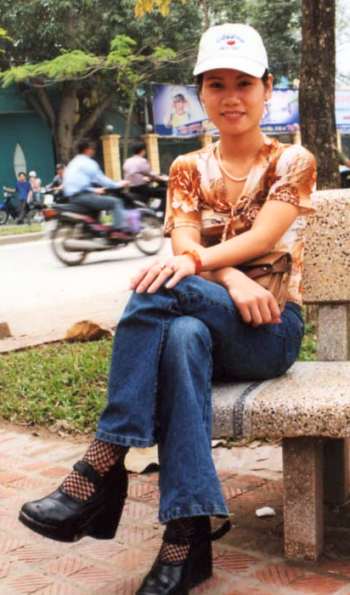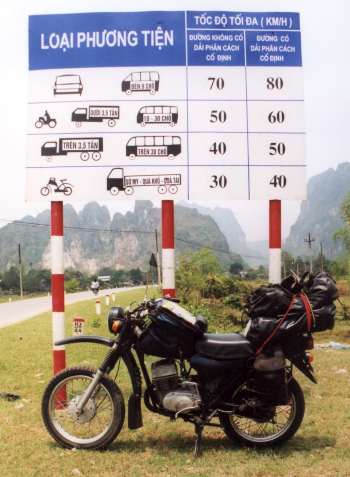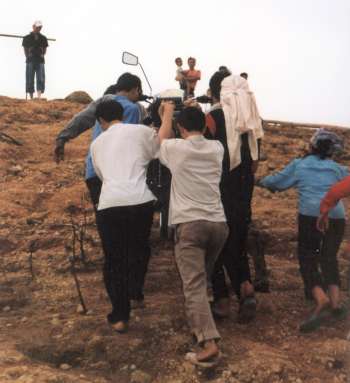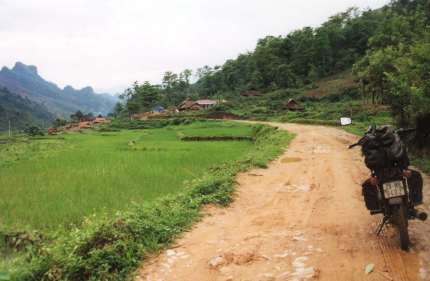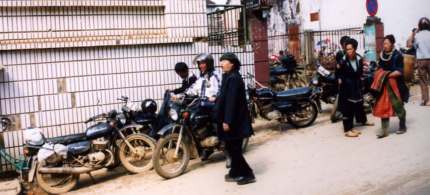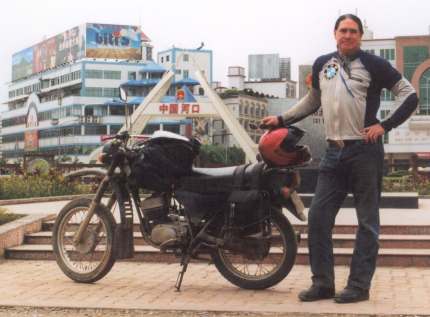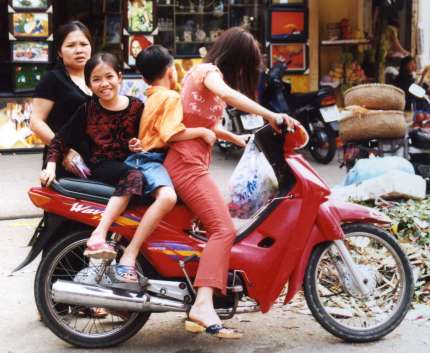|
|
This Vietnamese lady wanted to know when I would be ready to get married again. My answer referenced snakes and wine. "No where have I seen worse drivers than in Vietnam. I think it is sheer lunacy for anyone who lacks substantial experience driving in similar countries to attempt to do so here." So said a purported traveler of over 50 countries in the tourist book I had purchased. Under "Road Rules: the book read "Basically, there aren't any." Reading further it stated, "Over half the road fatalities in Vietnam are suffered by motorbike drivers." An inquiry to the Vietnam tourist office got a response of "Our country has 80 million people with 40 million motorbikes and cycles, and no training for the drivers. We recommend for safety and security you book a guided tour if you want to ride a motorcycle over here. And we strongly suggest you not travel alone." A motorcycle parking lot in Hanoi. What had piqued my interest was a short article in the Bangkok Post newspaper saying that due to the high number of road accidents the Vietnamese government was going hiring 7,000 new traffic police and boost the budget for equipment. I had just survived the annual Highway Killing Days in Thailand (Christmas and New Years) where they were snuffing four per hour, and 80% of all accidents involved motorcycles. A month earlier, I was in riding in Laos where one health worker told me motorcycle accidents accounted for more accidental deaths per year than any other factor. Before that, I had been riding in Cambodia, where motorcycles were killing more per day than gunfire, mines and unexploded ordinance. I thought, "Just how bad can Vietnam be? Worse than India? Worse than Sao Paulo, Brazil? Worse than Taiwan?" I had survived those places, plus the last months in Thailand, Cambodia and Laos. An acquaintance had just returned from riding solo in Vietnam. He did not have what I would term "substantial experience driving" a motorcycle and had survived, plus added he would go back. Faced with another period of Highway Killing Days (Songkran, or Water Festival) in Thailand, which included the locals throwing at Westerners buckets of water, firing it from high-pressure water guns, or using fire hoses to douse us, especially when on a motorcycle, I booked a flight into Hanoi to seek risky adventure. Vietnam had a maximum legal size for a motorbike of 125-cc; therefore, my 1,000-cc BMW was not allowed to cross the border into the country. Some have managed to get "big bikes" into Vietnam, but once inside unknowingly face confiscation by authorities. I decided to take my chances on finding an adequate motorcycle once I got there as I had done on one of my earlier rides around the world, so flew in with my riding gear, tool kit and a handful of cash. |
|
On the way into Hanoi from the airport, I saw a flat motorcyclist in the first four kilometers. He and his 100-cc Honda had been run over by a dump truck making a left turn in front of him. Wearing no helmet, his head had popped gray matter 10-15 feet away, as if someone had stepped on a tomato, and his motorcycle was the width of a bicycle. I thought, "Maybe it is as bad as the tourist book says it is over here." Vietnam is roughly the size of New Mexico, but it is long and thin. North and west of Hanoi are mountains, to the south flat fields and beaches along the 2,000 miles of coastline. The population density is more than 225 persons per square kilometer, making the country one of the world's highest for a mostly agricultural country. Per capita income is around $300 per year. That made me wonder how people could survive on $20 to $100 per month, especially in major cities like Hanoi. The price to western tourists for sleeping, eating and local sightseeing was low. I opted for a clean hotel in the Old Quarter with cable TV, air conditioning, 24-hour hot water, elevator, restaurant, in-room bathroom/toilet, telephone and free Internet use for $22.00 USD per night. Cheaper could be had for as little as $5.00, but I needed the room for only a few nights, and wanted something secure for my cameras and personal belongings while I hunted for a motorcycle during the day. The fat cats can also be right at home in Hanoi. Nearby was the Sofitel Metropole Hotel where rooms started at $200.00 per night and probably came with a turndown service at bedtime with a packaged chocolate on the pillow. I was quite comfortable with my $22.00 per night room. While my hotel did not have a lounge, my room came with a stocked refrigerator that included beer for seventy-five cents. Two blocks away I found Master Mechanic Cuong's Motorbikes at his shop Cuong's Motorbike Adventure.. He specializes in "Buying, Selling, Repairing and Renting." His fleet is comprised mostly of Russian-made Minsk 125-cc two stroke motorcycles. These are larger than the average motorcycles in Vietnam, which run in the 100-cc to 110-cc range, and used to come into Vietnam in large numbers from the Minsk factory in Belarus. The factory has shifted to bicycle production and last year produced only 40,000 motorcycles, few of which made it to Vietnam. I was able to locate the Minsk dealer in Hanoi, who had six new motorcycles for sale, for about $600.00 each. Master Mechanic Cuong (left) and "Minsker" Dan Dockery (right). Once I found Cuong, I was faced with some options. I could purchase a motorcycle, use it, and then sell it back to him at some loss. For $5.00 a day, I could rent one. Or I could buy one, ride it down to Ho Chi Min City (formerly Saigon), about 1,200 miles south and sell it there. While I was trying to decide on what to do over the next three weeks, Digby Greenhalgh dropped in the one room shop. Digby and his partner Dan Dockery run a motorcycle tour company called Explore Indochina and are principal movers and shakers in the Minsk Club. Digby was collecting a couple of clients who had booked a short tour. He told me what I could expect if I rode Highway 1A south to HCMC. He used terms like "flat," "rice fields," "traffic," "good paved road," and "pretty boring," but did sprinkle the description with "nice beaches," "DMZ, "Viet Cong tunnels" and "Saigon city." |
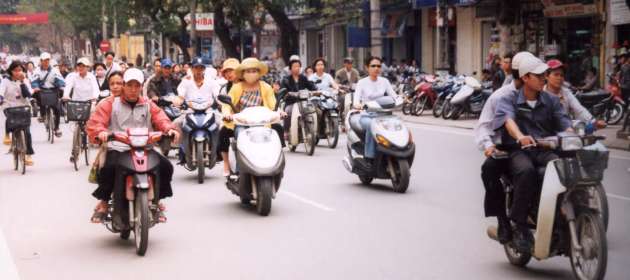
|
|
|
||
|
| ||
|
Copyright © Dr. Gregory W. Frazier 1999- All Rights Reserved.
Thoughts and opinions expressed here are those of the author, and not necessarily Horizons Unlimited
|
